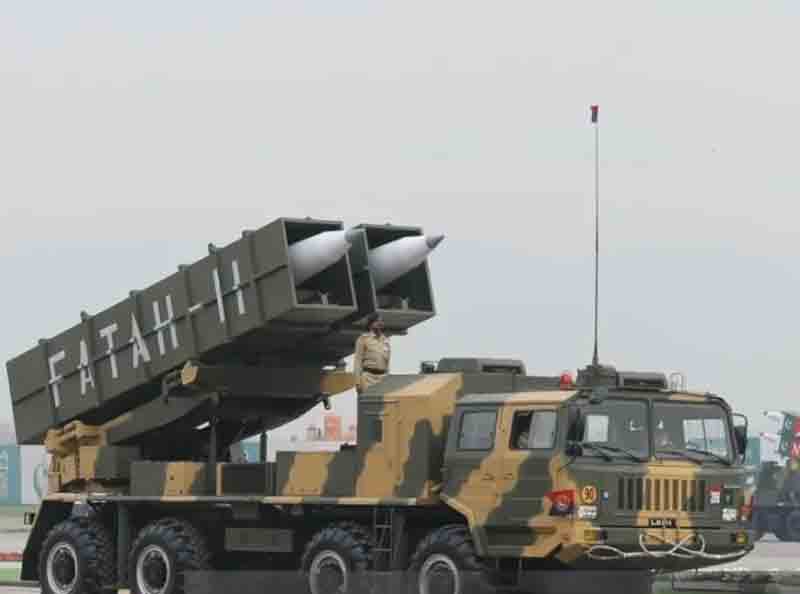In the final moments before a tentative ceasefire was established, temporarily halting the ongoing hostilities between the nuclear-capable nations of Pakistan and India, Islamabad introduced some of its most sophisticated and disruptive battlefield technologies—capabilities that have reverberated through Indian military leadership.
Central to this escalation were the Fatah-1 and Fatah-II Guided Multiple Launch Rocket Systems (GMLRS), developed by Pakistan’s National Engineering and Scientific Commission (NESCOM) and marketed internationally by the state-owned defense firm Global Industrial & Defence Solutions (GIDS). These systems signify Pakistan’s strategic advancement into high-precision, long-range strike capabilities—comparable to the U.S.-manufactured M142 HIMARS—but specifically designed for the South Asian context, aimed at both tactical interdiction and significant disruption of enemy infrastructure.
“#Pakistan using Fatah missiles. Fatah I (140 km range) and Fatah-II (400 km). The latter, according to the Diplomat, can hit targets with pointpoint accuracy – including the Russian-made S-400 Triumf missile systems owned by India.” –@ovaisjafar pic.twitter.com/sTDo25Lw2X
— The Friday Times (@TFT_) May 10, 2025
Created for deterrence and to achieve offensive balance in a region characterized by persistent tensions, the Fatah-series is perceived as a countermeasure to India’s growing arsenal of cruise missiles, surface-to-surface munitions, and comprehensive air defense systems.
The deployment of Fatah-1 and Fatah-II in active conflict scenarios represents a pivotal moment in South Asia’s developing precision-guided munitions (PGM) competition, marking a shift from traditional artillery bombardments to precise, high-impact operations. Observing the Pakistani military launch guided rockets from Fatah-series systems towards Indian territory starkly illustrates how the Indo-Pak conflict has evolved beyond mere border clashes, now encompassing long-range, standoff strike warfare.
Reports suggest that Fatah-II was specifically developed as a countermeasure to India’s Cold Start Doctrine (CSD), which is a limited warfare strategy aimed at facilitating swift conventional incursions into Pakistani territory before international intervention can occur. Pakistani military strategists contend that Fatah-II undermines this doctrine by threatening critical Indian command, control, and logistical centers situated deep behind the front lines, thus impairing India’s capacity to mobilize quickly without facing repercussions.
For the first time in the history of conflicts in the subcontinent, Indian rear-echelon military facilities, such as air bases, ammunition storage sites, and logistics centers, are now directly threatened by Pakistan’s conventional artillery systems. In response to Indian cruise missile attacks utilizing BrahMos and SCALP EG munitions on six vital Pakistani airbases—including Noor Khan, Mureed, and Shorkot—Islamabad reportedly retaliated with precise rocket barrages employing both Fatah-I and Fatah-II systems.
Some reports indicate that at least one Fatah-II rocket, which has a range of up to 400 km, was launched at a military installation in New Delhi, although the suppression of information by Indian authorities has hindered independent damage assessments.
#Pakistan launched Operation “Bunyan-ul-Marsoos,” striking Indian airfields and #BrahMos missile sites with Fatah-1/2 missiles and jets in response to #India‘s earlier drone and cruise missile strikes on several Pakistani air bases on the night of May 9. pic.twitter.com/fS0izrq9I4
— Shanghai Daily (@shanghaidaily) May 10, 2025
Both Fatah-1 and Fatah-II are equipped with sophisticated inertial and satellite navigation systems (INS/GPS), allowing them to accurately target high-value assets, including enemy radar installations, command centers, and fortified shelters. A regional defense analyst remarked, ‘These systems, from Fatah-I to the upcoming Fatah-II, are designed for both tactical and strategic uses, facilitating deep strikes into enemy territory.’
The deployment of these systems is a key element of Pakistan’s comprehensive strategy for achieving self-sufficiency in defense technology, with GIDS playing a crucial role in converting research into operational weapon systems. Both rocket systems are essential to a broader modernization initiative aimed at evolving Pakistan’s traditional artillery forces—historically dependent on unguided munitions—into a precision-strike capability suited for a network-centric warfare context.
The shift from older systems like the Yarmouk-series to the precision-guided Fatah-series signifies a strategic transition towards standoff strike warfare, allowing Pakistan to target critical enemy assets from beyond the reach of conventional air defense systems such as Barak-8 and Akash.
Defense analysts assert that the Fatah-series represents a significant advancement in the artillery capabilities of the Pakistan Army, enabling it to deter high-value incursions and project conventional force at operational ranges that were previously unattainable. A senior defense researcher stated, ‘The Fatah system illustrates Pakistan’s strategic shift from merely countering conventional forces to adopting precision-strike capabilities that can impose significant costs on enemy command and logistics.’ He highlighted that long-range precision strikes not only improve battlefield survivability but also exert psychological pressure by threatening vital infrastructure beyond the frontline.
Another expert remarked, ‘The shift from unguided artillery to precision GMLRS conveys a strategic message—the next conflict will focus on decisive strikes rather than sheer volume of fire.’ The enhanced range and accuracy of the Fatah-II, in particular, could potentially render India’s static air defense systems ineffective or necessitate a substantial reallocation of resources to safeguard inland bases that were once deemed secure.
Pakistan’s investment in the Fatah-series signifies a strategic transition towards advanced battlefield capabilities, allowing for precision strikes at greater distances without escalating to ballistic missile confrontations. These systems serve not only as deterrents but also as active combat instruments, transforming the traditional power dynamics between Islamabad and New Delhi by establishing high-precision standoff artillery as a key component in future conflicts.
The Fatah-series has significantly redefined Pakistan’s conventional deterrence strategy, creating overlapping areas of influence over vital Indian military assets while remaining below thresholds that could provoke nuclear responses.
Furthermore, the incorporation of GMLRS into Pakistan’s military doctrine indicates a future where conventional precision warfare may prevail in Indo-Pakistani conflict scenarios, altering the strategies both nations employ for preemptive or retaliatory actions.
In response to India’s increasingly sophisticated missile defense systems, the Fatah-series offers a cost-effective, high-impact alternative that complicates New Delhi’s strategic planning and necessitates a redistribution of air defense assets deep within Indian territory.
Discover more from Defence Talks | Defense News Hub, Military Updates, Security Insights
Subscribe to get the latest posts sent to your email.





